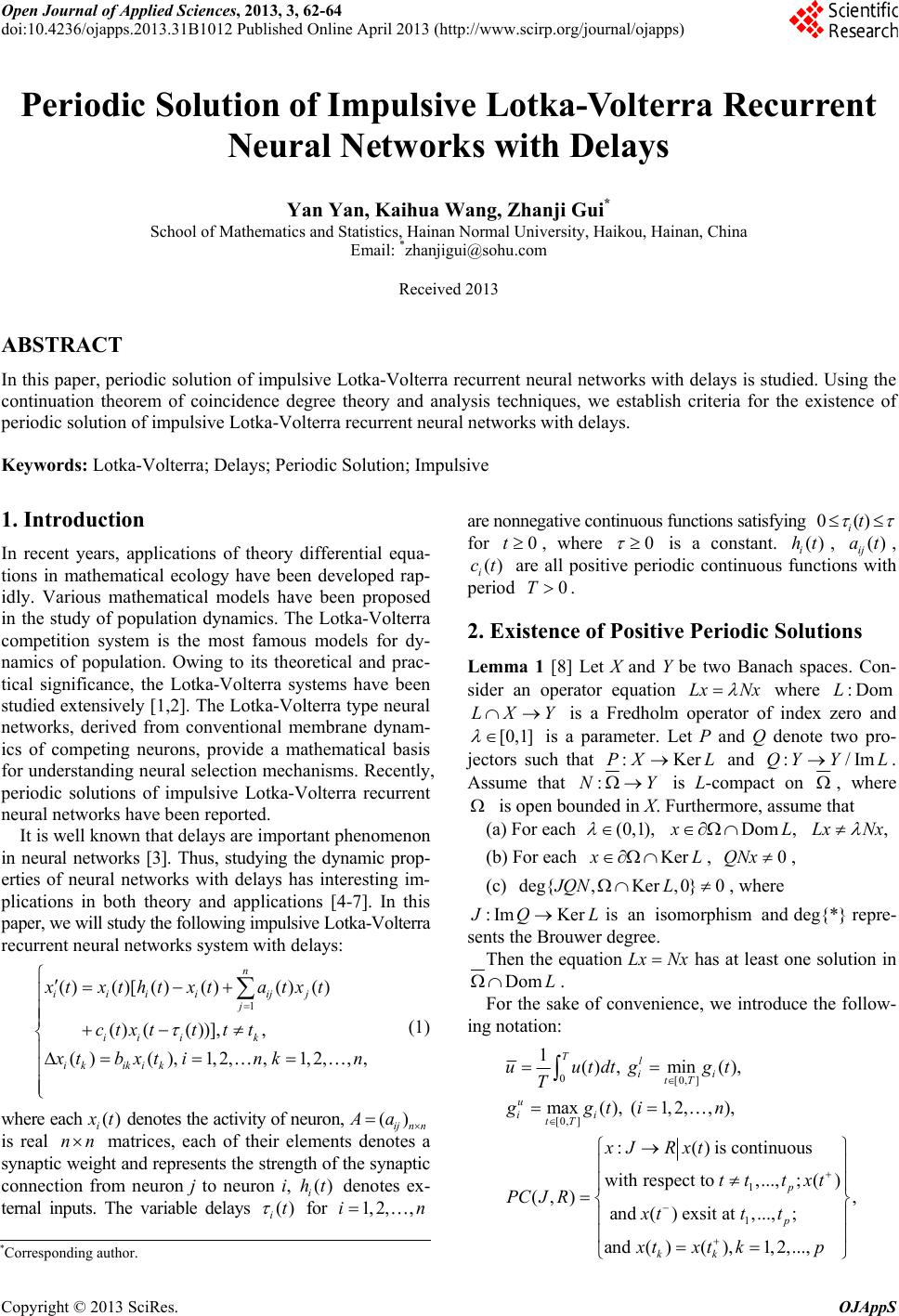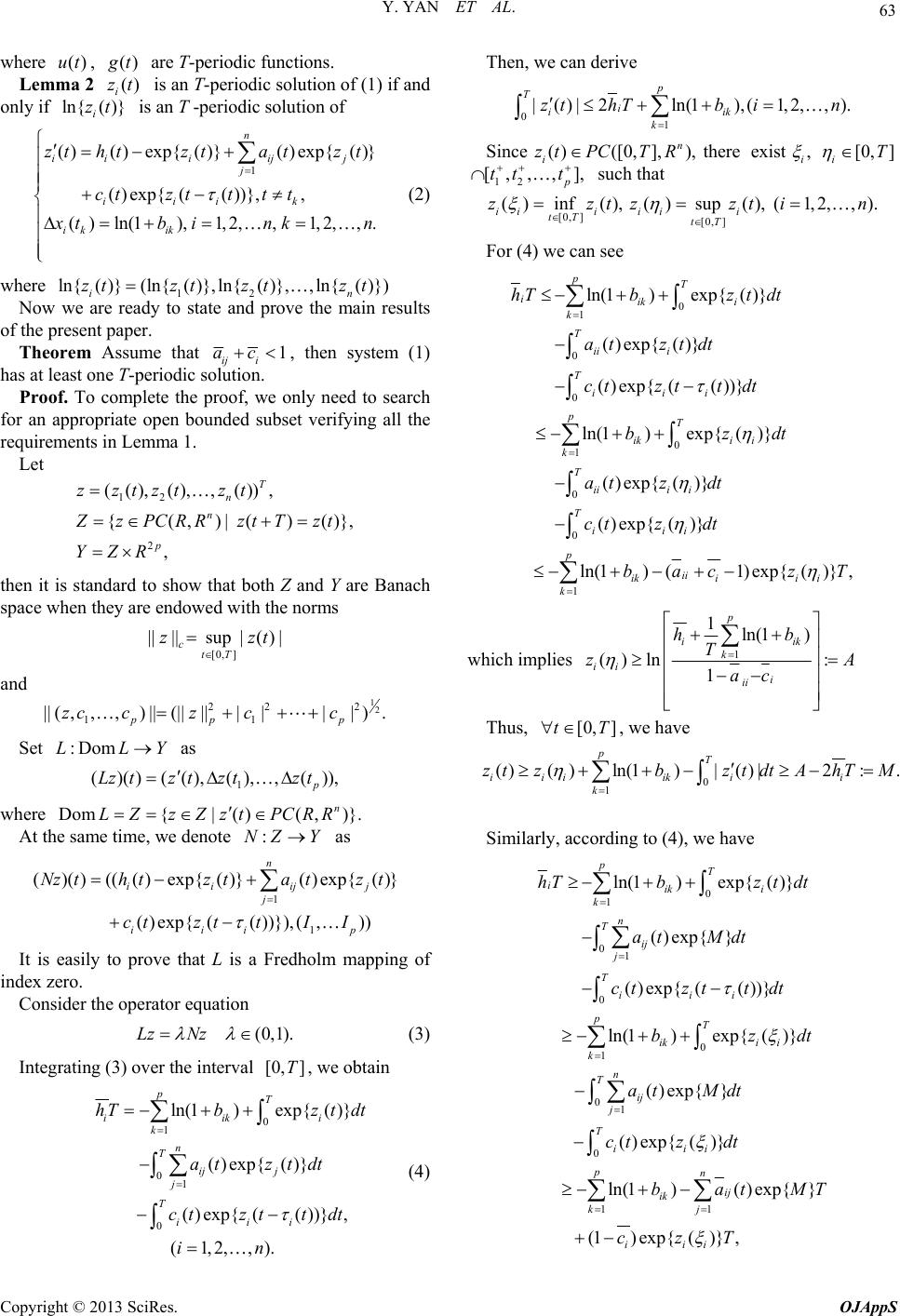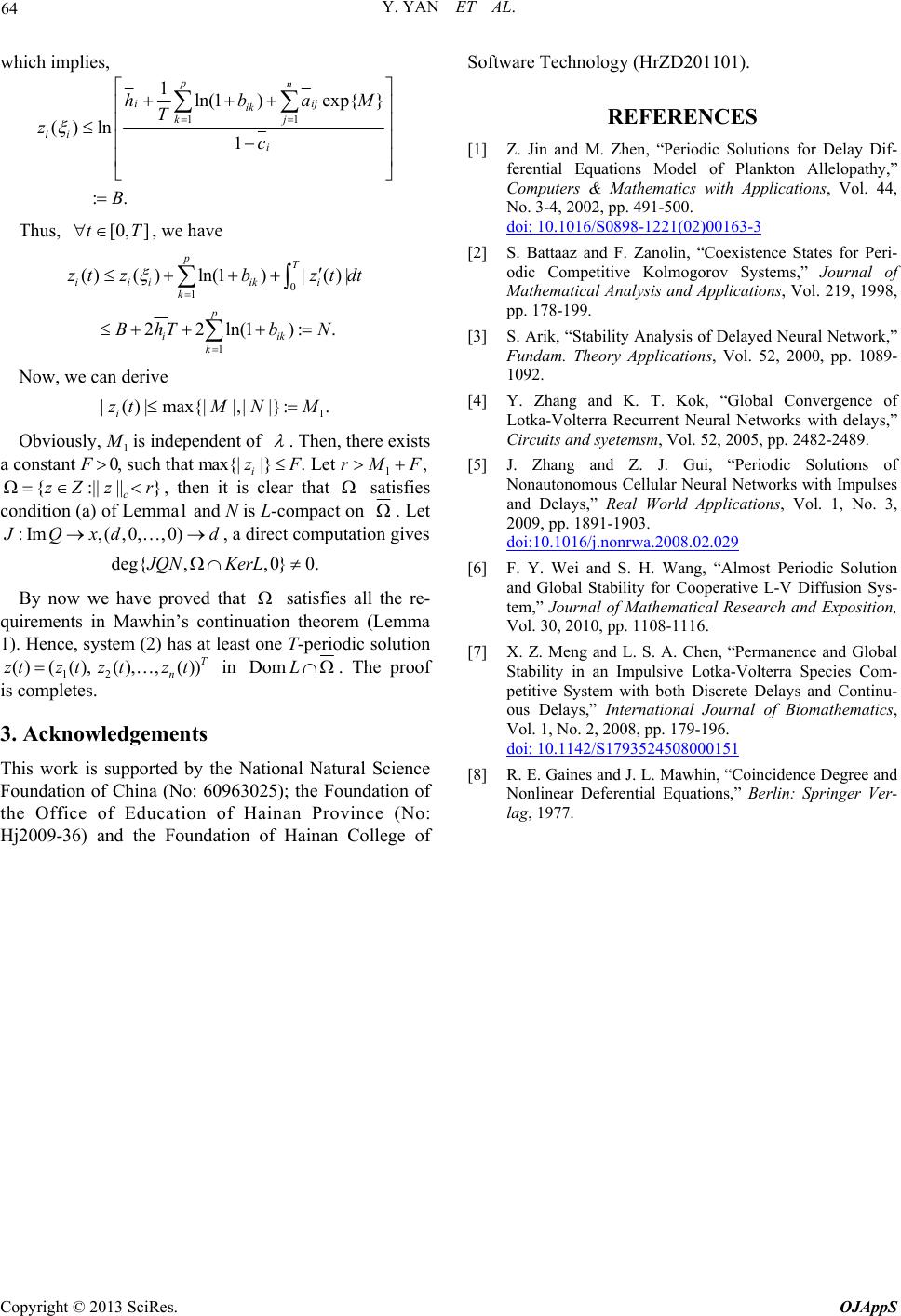 Open Journal of Applied Sciences, 2013, 3, 62-64 doi:10.4236/ojapps.2013.31B1012 Published Online April 2013 (http://www.scirp.org/journal/ojapps) Periodic Solution of Impulsive Lotka-Volterra Recurrent Neural Networks with Delays Yan Yan, Kaihua Wang, Zhanji Gui* School of Mathematics and Statistics, Hainan Normal University, Haikou, Hainan, China Email: *zhanjigui@sohu.com Received 2013 ABSTRACT In this paper, periodic solution of impulsive Lotka-Volterra recurrent neural networks with delays is studied. Using the continuation theorem of coincidence degree theory and analysis techniques, we establish criteria for the existence of periodic solution of impulsive Lotka-Volterra recurrent neural networks with delays. Keywords: Lotka-Volterra; Delays; Periodic Solution; Impulsive 1. Introduction In recent years, applications of theory differential equa- tions in mathematical ecology have been developed rap- idly. Various mathematical models have been proposed in the study of population dynamics. The Lotka-Volterra competition system is the most famous models for dy- namics of population. Owing to its theoretical and prac- tical significance, the Lotka-Volterra systems have been studied extensively [1,2]. The Lotka-Volterra type neural networks, derived from conventional membrane dynam- ics of competing neurons, provide a mathematical basis for understanding neural selection mechanisms. Recently, periodic solutions of impulsive Lotka-Volterra recurrent neural networks have be en reported. It is well known that delays are important phenomenon in neural networks [3]. Thus, studying the dynamic prop- erties of neural networks with delays has interesting im- plications in both theory and applications [4-7]. In this paper, we will study the following impulsive Lotka-Volterra recurrent neural networks system with delays: 1 ()()[ ()()()() ( )(( ))],, ()(),1,2,,1,2, ,, n iiii ijj j ii ik ik ikik xtxthtxta txt ctxtttt tbxti nkn (1) where each () i t denotes the activity of neuron, () ijn n Aa is real matrices, each of their elements denotes a synaptic weight and represents the strength of the synaptic connection from neuron j to neuron i, denotes ex- ternal inputs. The variable delays nn () i ht () it for are nonnegative continuous functions satisfying 1, 2,,in 0() it for , where 0t0 is a constant. i, , i are all positive periodic continuous functions with period . ()ht () ij at (ct)T0 2. Existence of Positive Periodic Solutions Lemma 1 [8] Let X and Y be two Banach spaces. Con- sider an operator equation Lx Nx where :DomL LX [0,1] Y is a Fredholm operator of index zero and is a parameter. Let P and Q denote two pro- jectors such that and QY . Assume that :PX KerL:/ImY L :NY is L-compact on , where is open bounded in X. Furthermore, assume that (a) For each (0,1), Dom , L , Lx Nx (b) For each Ker L, , 0QNx (c) deg{,,0} 0Ker JQN K L, where :Imer QL is an isomorphism and repre- sents the Brouwer degree. deg{*} Then the equation LxNx has at least one solution in Dom L. For the sake of convenience, we introduce the follow- ing notation: 0[0, ] [0, ] 1 1 1(), m ), ( : with res and ( in (), max(1,2,,), () is contin pect to,...,) (,) ) exsitat,..., and()(),1,2,..., uous ; ( ; , T ii tT u ii tT kk uu gt T ggi n Rxt tt PC JRt xtxt kp l tdtg t xJ xt p p txt t *Corresponding author. Copyright © 2013 SciRes. OJAppS  Y. YAN ET AL. 63 ()ut , () t ()zt where are T-perio dic fu n ctions. is an T-periodic solution of (1) if and only if an T -periodic solution of Lemma 2i ( )}zt is ln{ i 1 ()()exp{ ()}()exp{()} ( )exp{(( ))},, () ln(1),1,2,,1,2, ,. n iiiij j j iii k ik ik zt htztatzt ctztttt tbink n (2) n resent pa Theorem Assume that where 12 ((ln{()},ln{( )},,ln{ i zt ztzln{)}( )})ztt e reaNow we ardy to state and prove the main results of the ppe r. 1 ij i ac ution. , then system (1) has at least one T-periodic sol Proof. To complete the proof, we only need to search for an appropriate open bounded subset verifying requirements in Lemma 1. Let all the 12 ((),(),,()), {(,)| ()() T n n zztzt zt 2 }, , p zPCRRztT zt YZR that both Z e norms en it is standard to show th and Y are Banach space when they are endowed with th [0,] ||||sup|()| ctT zzt and 12 22 2 11 || (,,,) ||(||||||||). pp p zc czcc Set Y as j prove tL is a Fredholm mapping of inero. Consider the operator equation :DomLL 1 ()()((),(),,()), p Lztztztzt where Dom{|()(,)}. n LZzZztPCRR At the same time, we denote :NZ Y as 1 1 ()()((()exp{ ()}()exp{()} ()exp{(())}),(, )) n iiij j iii p Nzth tztatzt ctzttI I It is easily to hat dex z (0,1).Lz Nz (3) al , we obtain Integra t i ng (3) ov er the interv[0,]T 0 1 01 ij j j T (4) 0()exp{ (1,2,, ii ct z in ln(1)exp{( )} ()exp{ ()} (( ))}, ). pT iiki k n T i hTbz tdt at ztdt tt dt Then, we can deriv e 01 |()|2 ln(11,2,,). p Ti ii zt hTbn ),( k k i Since there exist ( )([0,],),n i ztPCT R, i [0, ] iT 2, 12 [, tt ( , ,], p t such that )inf(), () [0, ][0, ] sup(), ( 1,,). iii iii tT tT zinzztz t For (4) we can see 0 1ln(1 iik k hT b 0 0 0 1 0 1 )exp{( )} ()exp{ ()} ()exp{ ( exp{()} xp{ ()} ()exp{ ()} ln(1)(1)exp{ pT i T ii i T ii p i i k T i i iii p ii ik i k z tdt at ztdt ct ztd zdt z dt ctz dt bac z ()}, ii T which implies 0() e ii T at ())} ln(1 ) i T ik t t b 1 1ln(1) () ln: 1 p iik k ii i ii hb T zA ac Thus, [0, ] tT, we have 0 1 ()( )ln(1)|()|2:. pT iiiik ii k ztzbztdt AhTM Similarly, according to (4), we have 0 1 01 0 0 1 0 ()exp{} n T ij at Mdt 1 0 1 ln(1)exp{( )} ()exp{ } ())} ln(1)exp{()} ()exp{()} ln(1) pT iik i k n T ij j T iii pT iki i k j T iii p ik k hTbz tdt at Mdt cttdt bzdt ctz dt b () exp{ (tz 1()exp{ } (1)exp{()}, n ij j iii at MT czT Copyright © 2013 SciRes. OJAppS  Y. YAN ET AL. Copyright © 2013 SciRes. OJAppS 64 which implies, Software Technology (HrZD201101). 11 1ln(1)exp{ } () ln1 :. pn iij ik kj ii i hba T zc B M Thus, , we have REFERENCES [1] Z. Jin and M. Zhen, “Periodic Solutions for Delay Dif- ferential Equations Model of Plankton Allelopathy,” Computers & Mathematics with Applications, Vol. 44, No. 3-4, 2002, pp. 491-500. doi: 10.1016/S0898-1221(02)00163-3 [0,]tT [2] S. Battaaz and F. Zanolin, “Coexistence States for Peri- odic Competitive Kolmogorov Systems,” Journal of Mathematical Analysis and Applications, Vol. 219, 1998, pp. 178-199. 0 1 1 ()( )ln(1)|()| 22ln(1):. pT iiiiki k p iik k zt zbztdt BhTb N [3] S. Arik, “Stability Analysis of Delayed Neural Network,” Fundam. Theory Applications, Vol. 52, 2000, pp. 1089- 1092. Now, we can derive Obviously, [4] Y. Zhang and K. T. Kok, “Global Convergence of Lotka-Volterra Recurrent Neural Networks with delays,” Circuits and syetemsm, Vol. 52, 2005, pp. 2482-2489. 1 |()|max{||,||}:. i ztM NM 1 is independent of . Then, there exists such that Let a constant 0,Fmax{| |. i , then it is clear that and N is }zF L-com 1,rM F satisfies pact on { } r condition Lemma1 :||zZ (a)||c z of . Let :Im, ,,( ,00) Qxd d, a odirect c [5] J. Zhang and Z. J. Gui, “Periodic Solutions of Nonautonomous Cellular Neural Networks with Impulses and Delays,” Real World Applications, Vol. 1, No. 3, 2009, pp. 1891-1903. doi:10.1016/j.nonrwa.2008.02.029 mes By now we have proved that satisfies all the re- qu nun theorem (Lemma 1), system (2) has at least one T-periodic solution in putation giv deg{,,0} 0. JQN KerL [6] F. Y. Wei and S. H. Wang, “Almost Periodic Solution and Global Stability for Cooperative L-V Diffusion Sys- tem,” Journal of Mathematical Research and Exposition, Vol. 30, 2010, pp. 1108-1116. atioirements in Mawhin’s conti . Hence [7] X. Z. Meng and L. S. A. Chen, “Permanence and Global Stability in an Impulsive Lotka-Volterra Species Com- petitive System with both Discrete Delays and Continu- ous Delays,” International Journal of Biomathematics, Vol. 1, No. 2, 2008, pp. 179-196. doi: 10.1142/S1793524508000151 12 ()((), (),,())T n ztz tztztDom L. The 3. Acknowledgements Th by the National Natural Science Foo: 60963025); the Foundation of the Office of Education of Hainan Province (No: Hd f proof is completes. is work is supported undation of China (N[8] R. E. Gaines and J. L. Mawhin, “Coincidence Degree and Nonlinear Deferential Equations,” Berlin: Springer Ver- lag, 1977. j2009-36) anthe Foundation oHainan College of
|